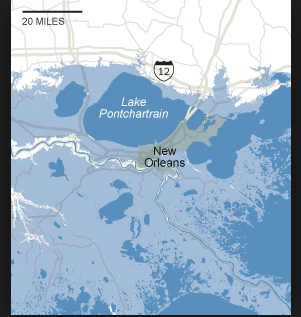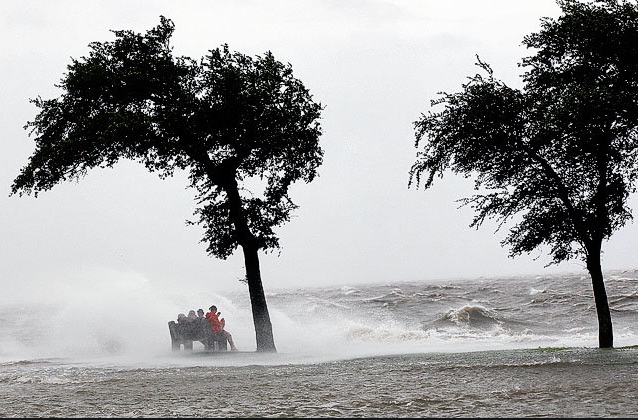Editor’s Note: The following series “Big Easy and the Environment” is a week-long series curated by Lindsay Hardy as part of the Digital Research Internship Program in partnership with ViaNolaVie. The DRI Program is a Newcomb Institute technology initiative for undergraduate students combining technology skillsets, feminist leadership, and the digital humanities.
March is the beginning of spring in New Orleans, the trees are changing, the pollen is falling, and the humidity is just starting to creep in. As the seasons quickly change each year, and New Orleans becomes warmer, it makes people start to question: how quickly is New Orleans climate and environment changing? This grouping of articles explores and appreciates New Orleans’ changing environment as it relates to film in the past, present, and future. “Climate Change and Sea Level Rise in New Orleans” was originally published on NolaVie on July 31st, 2013, by Reagan Reed. One of the most threatening aspects of climate change to the city of New Orleans and its environment is sea level rise. This article works to define each component of climate change and sea level rise, providing statistics and data on how New Orleans is changing, and how we can combat those changes.

This is what the city would look like with a five foot rise in sea level. Photo courtesy of the New York Times.
The story of the Lost City of Atlantis has been told for as long as anyone can remember. However, what if this story of an underwater city turned out to be more of a prophesy than a myth? Under current conditions, this may be the case for the city of New Orleans. As global climate change causes the sea level to rise, the thought of an entirely flooded New Orleans becomes a possibility. What caused this combination of unfortunate circumstances? How are humans involved? Is there anything we can do to prevent this fate? While many have previously explored questions of climate change and sea level rise, this module will look at their effects on New Orleans specifically and why these issues are particularly important to the city.
Sea level change is an ancient process with multiple causes, which goes back millions of years (Davis, Richard A. Jr. Sea Level Change in the Gulf of Mexico. College Station: Texas A&M University Press, 2011. Print. Page 11). However, before one can understand how climate change and global warming affect this process (and in turn, New Orleans), one must first understand the basics of what climate change is and how it works. The key concept to understanding global warming is the greenhouse effect. Simply put, certain “greenhouse gasses” in the atmosphere (most importantly carbon dioxide) retain solar heat reflected from the Earth’s surface as infrared radiation. This prevents said heat from leaving the atmosphere, which causes the Earth’s average temperature to rise (“How Climate Change Works.” Africa News Service. Web. 12 July 2013). Relatively recently in human history, factors such as the burning of fossil fuels and deforestation have released greenhouse gasses into the atmosphere, thus “thickening the blanket” of gasses insulating Earth (“How Climate Change Works.” Africa News Service. Web. 12 July 2013). However, this process works in reverse as well. By reducing the activities that release greenhouse gasses, it is possible for people to curb the rate of global warming, and thereby slow sea level rise.

The Brown Pelican’s habitat is in danger due to rising sea level. Photo by Rodney Cammauf.
But does climate change affect the sea level? According to the National Oceanographic and Atmospheric Administration (NOAA), water expands as it warms, therefore a warming ocean means an expanding ocean (“Sea Level is Rising at an Increasing Rate.” Web. 12 July 2013). The Earth also has many ice sheets located along various coasts, most significantly in Antarctica. As the global temperature rises, these ice sheets melt and contribute water to the oceans. While only one of many causes of sea level rise, environmental researcher Richard A. Davis, Jr. calls the melting of ice sheets “probably the most important cause of eustatic [global] sea level at the present time” (“Sea Level is Rising at an Increasing Rate.” Web. 12 July 2013).
As science and technology evolve, evidence of human-caused global warming and sea level rise becomes increasingly convincing. According to the NOAA, scientists have shown that while the sea level changed little between 0 and 1900 AD (before modern industrialization), it has risen steadily by about 1 to 2.5 millimeters (.04 to .1 inches) per year since (“Sea Level is Rising at an Increasing Rate.” Web. 12 July 2013). However, this number is rapidly increasing. In 1992, a new satellite imaging system indicated an annual rise of about 3 millimeters (.12 inches), a drastic change from the previous figures (“Sea Level is Rising at an Increasing Rate.” Web. 12 July 2013).
So how does all of this affect New Orleans? Due to New Orleans’s location below sea level, the city is in increased danger as a result of sea level rise. According to a New York Times article, a probable estimate for sea level rise in the next 100 to 300 years is five feet. As a result of increased pressure on the levees of the city, it is estimated that 88% of the city would be underwater due to a levee breach or flooding (“What Could Disappear.” New York Times. Web. 12 July 2013). This is a staggering figure, especially when compared to other coastal American cities. The majority of coastal cities have projected single-digit flooding at a five-foot increase, such as Mobile, AL (4%), New York, NY (7%), and Boston, MA (9%). Only one city, Miami Beach (94%) has a higher projected flooding percentage than New Orleans, primarily because Miami Beach has a comparable sea level to NOLA and the fact that it is a barrier island, which drastically increases its risk.
In addition to potentially flooding the city, rising sea levels could devastate local wetlands. As sea levels rise, wetlands disappear in a process called subsistence. The land itself is eroded due to factors such as lack of sediment deposition and bedrock, while at the same time the global sea level rises at an increasing rate each year (“Subsistence and Sea Level Rise in Louisiana: A Study in Disappearing Land.” National Oceanic and Atmospheric Administration. NOAA Magazine Online. Web. 13 July 2013). At the current rate of deposition, nearly 15,000 square miles of wetlands will be underwater in the next 70 years (“NOAA–LSU Study: Portions of Gulf Coast Sinking at Significant Rate.” National Oceanic and Atmospheric Administration. Web. 13 July 2013). This presents a serious threat to local wildlife by destroying their habitat. Some animals that could be threatened by shrinking wetlands include culturally-significant animals such as the brown pelican (the state bird and namesake of the New Orleans Pelicans basketball team) and the nutria (a mascot of the New Orleans Zephyrs minor-league baseball team).

People on the seawall during Hurricane Issac. These types of extreme storms are more common now than ever. Photo by Gerald Herbert.
Climate change and sea level rise do not occur in a vacuum. While they have the potential to be quite destructive on their own, they also have the potential to exacerbate a more familiar environmental problem: hurricanes. While it is common knowledge that hurricanes cause flooding in New Orleans and people have been dealing with this issue since the city was founded, the danger has never been higher. Storms are, on average, more powerful now than at any other time in history. In fact, Gulf storm intensity has risen significantly since the 1970s (“Stronger Hurricanes.” The Congressional Committee on Energy Independence and Global Warming. Web. 13 July 2013). The reason for this is the rising temperature of the Earth’s water due to global warming. Warm water is an essential part of the development of storms, and warmer water typically indicates a stronger storm. Even slight variations (such as the roughly one degree Fahrenheit between the 1970s and today), can drastically change weather patterns (“Stronger Hurricanes.” The Congressional Committee on Energy Independence and Global Warming. Web. 13 July 2013). Coupled with the fact that higher sea level means higher stress on levees, and that storm tide (storm surge plus astronomical tide) is higher when the sea level’s base height is higher, global warming could spell disaster for New Orleans.
Attempts at controlling the increasing sea level have been made by government agencies. Lately they have even been incorporating sea level rise into their policies and calculations for the future. For example, this year the U.S. Army Corps of Engineers reviewed plans for a levee system designed to protect the nearby community of Houma, LA. Former models neglected the role of rising sea levels; a factor that becomes more significant when considering the levee is meant to last until 2085. Incorporating this change was an important variable in raising the Corps’ confidence from the original plan to now (Schleifstein, Mark. “Corps Finds the Price Tag on Morganza-to-the-Gulf Levee System is justified.” Times-Picayune. Print).
The federal government has also been indirectly involved in the fight against sea level rise for years. Car emissions (such as CO2) are a major contributor to global warming. The first nationwide automobile emission policies were enacted in 1968, and soon after, the Environmental Protection Agency (EPA) and the Clean Air Act were established in 1970 (“Milestones in Auto Emissions Control.” Environmental Protection Agency. Web. 22 July 2013). The Clean Air Act puts similar restrictions on industrial sources of pollution as well (“Simplified Clean Air Act.” Environmental Protection Agency. Web. 22 July 2013). What this means for sea level is that with regulations on emissions, the amount of greenhouse gasses in the atmosphere will decrease. This translates to a slowed rate of global warming and slowed rate of global sea level rise.
Louisiana has a thriving oil industry, so these emissions regulations effectively force Louisiana to protect itself from itself. Historically, large oil companies have released both liquid and gaseous chemical waste, especially into predominantly minority neighborhoods (Bullard, Robert. “Environmental Racism Revisited.” Dumping in Dixie. Boulder, CO: Westview Press. Print). Federal emissions standards on industry, while not perfect, do much to curb the human health problems, as well as the environmental factors that lead to global warming.
While “A New Atlantis” may be a bit melodramatic, there certainly is a special danger for New Orleans associated with sea level rise. While it is a global issue that no individual can solve, it also has a solution to which all can contribute. Knowledge of the dangers of sea level rise is the first step to altering our behaviors in order to curtail it, as well as government policy to protect us from it.
 NOLAbeings
Multimedia artist Claire Bangser created NOLAbeings as a portrait-based story project that marries...
NOLAbeings
Multimedia artist Claire Bangser created NOLAbeings as a portrait-based story project that marries...
 Data corner: Adobe Suite (create a PDF, social media graphic, presentation, edit a photo and video
Data corner is where you go to work with analytics and top tech skills. It takes on everything from PERL and SQL to Canva and Sprout Social.
Data corner: Adobe Suite (create a PDF, social media graphic, presentation, edit a photo and video
Data corner is where you go to work with analytics and top tech skills. It takes on everything from PERL and SQL to Canva and Sprout Social.
